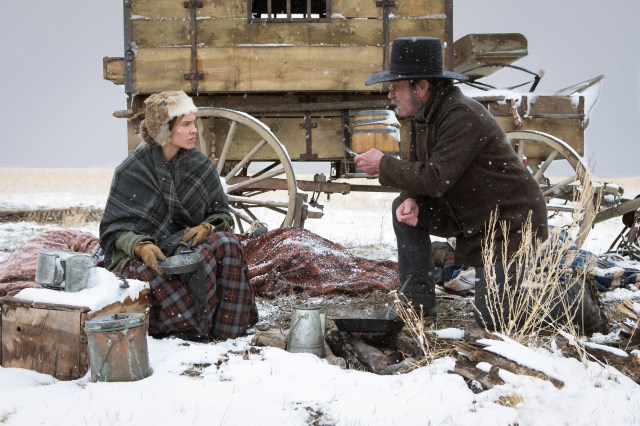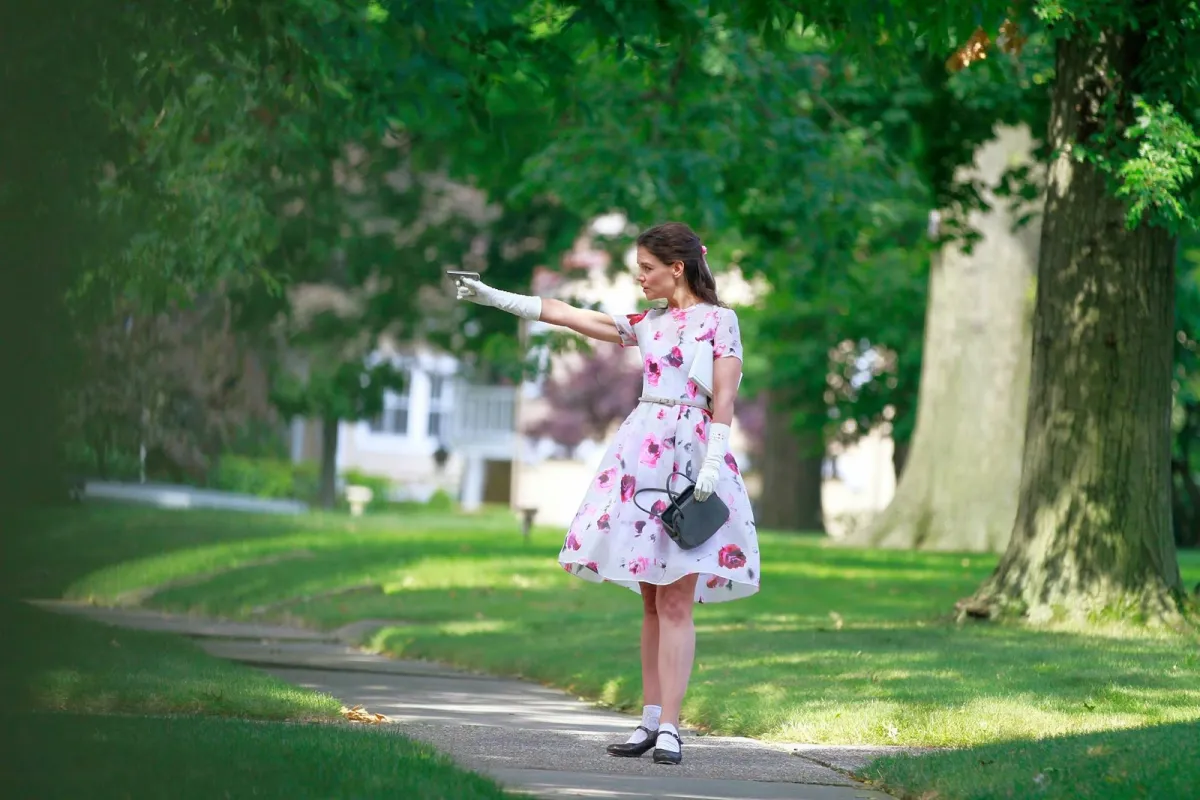Two newly-released black comedies this week share a common thread beyond their genre: their inability to effectively address important issues. Both Miss Meadows and The Homesman attempt to engage in serious genre twists – an assassination thriller and an old-fashioned Western from post-modern feminist slants – and while both get an E for effort, neither film succeeds in their grand ambitions.
The less successful of the two, Karen Leigh Hopkins’s Miss Meadows, wants to be an ambitious, cheeky comedy about a kindergarten teacher (Katie Holmes) who occupies her spare time with a gun, ridding the world of cat callers and child molesters. Understandably, Hopkins takes a certain delight in seeing the youthful, child-voiced Holmes tap dancing one moment in a 50s skirt with animated animals, only to be knocking off a menacing guy in the next. Unfortunately, once Hopkins gives away the joke, Miss Meadows becomes one unpleasant cinematic experience.
In one of her first leading roles in a considerable time, Katie Holmes is good (but not great) in the title role. Holmes gets knocked in reviews often for being cold and frigid on screen, and here she certainly does use that composed, steely disposition. But Holmes is a talented actress who can show sensitive subtly when allowed time to develop a character; and despite a bumpy start, Holmes sells Meadows as a female version of Dexter who is far more damaged then the outside world sees.
Unfortunately, because of how subtly Holmes plays the character from early on, Hopkins’s flippant writing and direction makes the eventual social commentary about child abuse seem like an out-of-place gimmick in what is essentially just a lame romantic comedy.
Hopkins can’t commit to the idea of making the bizarre mix of Mary Poppins-meets-Death Wish she initially promised. But she also can’t bring herself to turn the bizarre comedy into a psychological drama. Miss Meadows is ultimately neither.
Hopkins does make obvious attempts to make a visually interesting film, but nothing really comes together. Certainly, Katie Holmes’s wardrobe, in adult versions of doll clothes, work the best thematically. But the movie’s animation and production design look cheap and lack the extreme stylizations necessary to maintain the dark tone of the comedy. As for the music and editing, the motivation is at its best when it attempts to be quirky and ironic, even if it is there simply to be different. But Hopkins pulls back too quickly from some of her early bizarre choices, choosing to dig into the narrative, and allows the movie to fall into the predictable far too early.
Hopkins is best known as a writer, but her best work remains the comedy Welcome Home, Roxy Carmichael, a film which had both a sincere heart and satirical perspective. Since then, Hopkins has played it remarkable safe as a writer (the sappy Stepmom and the truly horrible Because I Said So). Ironically, despite returning to her dark roots in this story, Miss Meadows is closer to her later ventures, though it begs to have a cheekier, extreme sensibility. After 90 minutes sitting with the film, I have no idea what her feelings on how to deal with child abuse or abuse. Miss Meadows is a movie begging to have been a short film; preferably one which is dark, dirty, and weird, and without the uninspired romantic comedy subplot with James Badge Dale we have here.

If Miss Meadows is tackling too little for an entire movie, Tommy Lee Jones’s The Homesman has to deal with far too much plot. The Homesman is based on a mid-20th century novel by Glendon Swarthout, who also happens to be responsible for the novel Where the Boys Are, a feminist take on the college mating game. It comes as little surprise, then, that Swarthout’s novel would take a similar approach to gender with the Western dime novel, and this adaption of The Homesman has obvious similarities to the classic Western films of the 1950s.
The Homesman is, like so many Westerns, ultimately a road movie, albeit on horseback. Mary Bee Cuddy (Hilary Swank) is a single woman of a certain age living alone, relatively successfully. She has money, a working farm, and even a home with a wood floor, which is far more than the other women living in her surroundings. Those women (Grace Gummer, Miranda Otto, Sonja Richter) have all been driven mad over a particularly harsh winter. The women must leave their homes and return to civilization, and it is the decision of the preacher that one secured wagon should transport all of them. That one person to take on the responsibility is Cuddy, who thinks she will have to go it alone – until she meets a drifter named George (Tommy Lee Jones).
I’ll be honest: I thought I was going to love this movie when it first began. Swank is a phenomenal actress, but one with a particular type. Here, she is perfectly cast as Cuddy; tough, confident, and exactly the type of woman who not only would make it on her own, but thrive under those conditions. And yet you instantly sense the sadness in her which can come from true loneness. The dramatic juxtaposition of seeing Swank’s tough Cuddy in her element compared to the women driven insane by the harsh conditions inside and outside the home is a powerful comment on the life of women who ventured out west.
But once Tommy Lee Jones enters the pictures, there begins a tug of war for the picture between the two characters. Swank represents the realism the film goes for, while Jones is almost a parody of the American cowboy, throwing the film completely off balance. The movie quickly starts to feel disjointed (even within scenes), and every attempt to have compassion for these sick, disturbed women is undercut by Jones’ character and the script’s jokes at their expense. Eventually, the film goes completely over the rails, becoming a completely different movie.
One of the massive problems Jones has with this film is that it feels so bloated in characters and story, it seems completely unstructured. There are appearances by former costars (James Spader and Meryl Streep both appear in the opening credits) which amount to out-of-place cameos that could have been cut to maintain some tonal consistency and momentum. The film seems to end multiple times, only to have some scenes which go nowhere. This seems a case of a director who fell in love with his material, and couldn’t bring himself to cut and edit when needed.
It is all too bad, because there is so much to like about The Homesman, so much I almost finding myself wanting to recommend it. Tommy Lee Jones is a director with an inspired cinematic eye for capturing the terrifying scope of natural landscapes which would, by other filmmakers, be considered beautiful. His lack of romantic nostalgia for the Western, while still embracing some conventions, strikes a good balance, and his feminist perspective is a welcome addition to the Western genre. And the performances by all four women happen to be great, as is Jones’s performance; his character, like Spader’s, is simply too big and weird for the film he initially seemed to be making.
The fact that both these films struggle to tackle such big issues isn’t simply a problem with theme and narrative structure; it is ultimately the downfall of both films. There are many films which succeed at mixing dark comedy with social commentary, but in most cases, these films go to extremes or take dramatic turns. Here, the social issues addressed seem insignificant to the filmmakers, leaving the sour impression that their inclusion in the story was ultimately opportunistic and disrespectful. If either director had been more sincere or more satirical in their approach, the films might have worked; but neither Miss Meadows nor The Homesman had the courage of their initial convictions, causing both films to fall flat.
Lesley Coffin is a New York transplant from the midwest. She is the New York-based writer/podcast editor for Filmoria and film contributor at The Interrobang. When not doing that, she’s writing books on classic Hollywood, including Lew Ayres: Hollywood’s Conscientious Objector and her new book Hitchcock’s Stars: Alfred Hitchcock and the Hollywood Studio System.
Are you following The Mary Sue on Twitter, Facebook, Tumblr, Pinterest, & Google +?









Published: Nov 14, 2014 08:00 pm